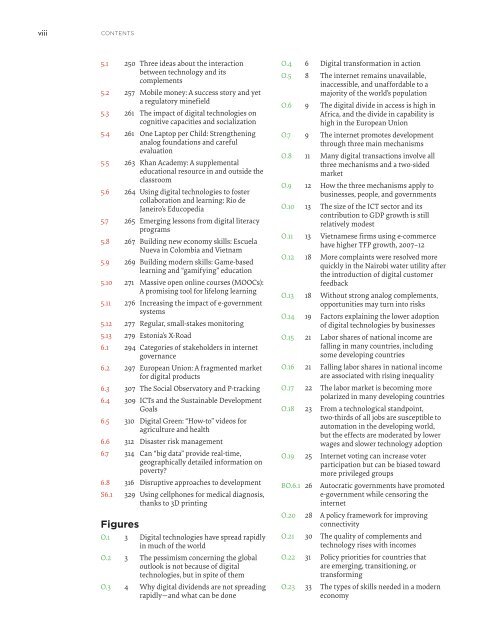Authorized Authorized
eERqs
eERqs
You also want an ePaper? Increase the reach of your titles
YUMPU automatically turns print PDFs into web optimized ePapers that Google loves.
viii<br />
CONTENTS<br />
5.1 250 Three ideas about the interaction<br />
between technology and its<br />
complements<br />
5.2 257 Mobile money: A success story and yet<br />
a regulatory minefield<br />
5.3 261 The impact of digital technologies on<br />
cognitive capacities and socialization<br />
5.4 261 One Laptop per Child: Strengthening<br />
analog foundations and careful<br />
evaluation<br />
5.5 263 Khan Academy: A supplemental<br />
educational resource in and outside the<br />
classroom<br />
5.6 264 Using digital technologies to foster<br />
collaboration and learning: Rio de<br />
Janeiro’s Educopedia<br />
5.7 265 Emerging lessons from digital literacy<br />
programs<br />
5.8 267 Building new economy skills: Escuela<br />
Nueva in Colombia and Vietnam<br />
5.9 269 Building modern skills: Game-based<br />
learning and “gamifying” education<br />
5.10 271 Massive open online courses (MOOCs):<br />
A promising tool for lifelong learning<br />
5.11 276 Increasing the impact of e-government<br />
systems<br />
5.12 277 Regular, small-stakes monitoring<br />
5.13 279 Estonia’s X-Road<br />
6.1 294 Categories of stakeholders in internet<br />
governance<br />
6.2 297 European Union: A fragmented market<br />
for digital products<br />
6.3 307 The Social Observatory and P-tracking<br />
6.4 309 ICTs and the Sustainable Development<br />
Goals<br />
6.5 310 Digital Green: “How-to” videos for<br />
agriculture and health<br />
6.6 312 Disaster risk management<br />
6.7 314 Can “big data” provide real-time,<br />
geographically detailed information on<br />
poverty?<br />
6.8 316 Disruptive approaches to development<br />
S6.1 329 Using cellphones for medical diagnosis,<br />
thanks to 3D printing<br />
Figures<br />
O.1 3 Digital technologies have spread rapidly<br />
in much of the world<br />
O.2 3 The pessimism concerning the global<br />
outlook is not because of digital<br />
technologies, but in spite of them<br />
O.3 4 Why digital dividends are not spreading<br />
rapidly—and what can be done<br />
O.4 6 Digital transformation in action<br />
O.5 8 The internet remains unavailable,<br />
inaccessible, and unaffordable to a<br />
majority of the world’s population<br />
O.6 9 The digital divide in access is high in<br />
Africa, and the divide in capability is<br />
high in the European Union<br />
O.7 9 The internet promotes development<br />
through three main mechanisms<br />
O.8 11 Many digital transactions involve all<br />
three mechanisms and a two-sided<br />
market<br />
O.9 12 How the three mechanisms apply to<br />
businesses, people, and governments<br />
O.10 13 The size of the ICT sector and its<br />
contribution to GDP growth is still<br />
relatively modest<br />
O.11 13 Vietnamese firms using e-commerce<br />
have higher TFP growth, 2007–12<br />
O.12 18 More complaints were resolved more<br />
quickly in the Nairobi water utility after<br />
the introduction of digital customer<br />
feedback<br />
O.13 18 Without strong analog complements,<br />
opportunities may turn into risks<br />
O.14 19 Factors explaining the lower adoption<br />
of digital technologies by businesses<br />
O.15 21 Labor shares of national income are<br />
falling in many countries, including<br />
some developing countries<br />
O.16 21 Falling labor shares in national income<br />
are associated with rising inequality<br />
O.17 22 The labor market is becoming more<br />
polarized in many developing countries<br />
O.18 23 From a technological standpoint,<br />
two-thirds of all jobs are susceptible to<br />
automation in the developing world,<br />
but the effects are moderated by lower<br />
wages and slower technology adoption<br />
O.19 25 Internet voting can increase voter<br />
participation but can be biased toward<br />
more privileged groups<br />
BO.6.1 26 Autocratic governments have promoted<br />
e-government while censoring the<br />
internet<br />
O.20 28 A policy framework for improving<br />
connectivity<br />
O.21 30 The quality of complements and<br />
technology rises with incomes<br />
O.22 31 Policy priorities for countries that<br />
are emerging, transitioning, or<br />
transforming<br />
O.23 33 The types of skills needed in a modern<br />
economy


